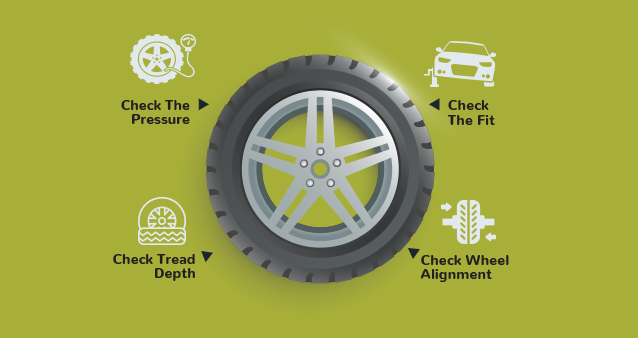When Did You Last Check Your Tyres?

The state of your tyres plays a major role in your car's roadworthiness and safety. When was the last time you checked them?
Remember that part of your driver's licence test where you had to inspect the outside of your vehicle before you were allowed to get in? It's unlikely you've ever done that since that fateful day at the testing station, but not doing so puts your safety at risk, and could affect your insurance claim in the event of an accident.
Tyres are the most overlooked part of a vehicle, yet also the most important. (That's why we offer easy comparisons on Tyre and Rim Guard quotes. We want you to be safe out there, fam.)
"Badly maintained tyres are one of the leading causes of car accidents in South Africa," says Ricardo Coetzee, Head of Auto & General Insurance. "We urge motorists to get into the habit of regular inspections, and tyre and rim maintenance, as well as making well-informed decisions when purchasing tyres."
The National Road Traffic Act of 1996 governs, among other things, the fitness of vehicles and drivers. It covers the basics such as the need to have a licence to operate a motor vehicle, and states what constitutes roadworthiness, and places the responsibility for maintaining it firmly on the driver.
Roadworthiness is determined by the regulations linked to this Act, and Regulation 212 speaks to the fitness of a vehicle's tyres and rims. Your vehicle's tyres need to have at least 1mm of tread for the vehicle to be considered roadworthy. Some tyres have a wear indicator and when the tread is level with it, the vehicle is considered unroadworthy and that tyre must be replaced.

Roadworthiness and your car's tyres
Coetzee says that in assessing a claim, an insurer always assesses the overall roadworthiness of the vehicle and whether it may have played a role in the incident. "The National Road Traffic Act legislates the standards to which all roadgoing vehicles are held in terms of roadworthiness," he says. "However, from a claims decision-making point of view, other factors like the materiality of the unroadworthiness of a vehicle needs to be considered."
He sketches two scenarios: "In scenario one, the driver of a vehicle with four illegal tyres is unable to stop on a wet road while braking and skids into a stationary vehicle. In scenario two, the same unroadworthy vehicle is stationary at a traffic light and another vehicle collides with it. It stands to reason that in scenario one, the condition of the tyres contributed to how the accident happened and are therefore material to the loss. In scenario two, this is not the case and the tyres had no influence," he explains.
This isn't all legal theory. In a real-world case in 2021, an insurer rejected an accident claim from a driver who said that her vehicle's tyres had burst before she'd crashed into a wall, because an assessment by an expert had determined that her tyres were worn before the incident occurred, which rendered her vehicle unroadworthy.
The case was referred to the Ombudsman for Short Term Insurance, who determined that the investigation hadn't been completed properly and ordered the insurer to pay the claim. The outcome could have been very different if the determination about the (un)roadworthiness of the tyres had been maintained.
Tyre Fitness First
It's not just tyre wear levels that play a role in determining their fitness. Their age, inflation levels and how they're used should also be monitored. "Here we are guided by manufacturers' specifications, where the manufacturer will stipulate the safe age of a tyre," says Coetzee. "Again, the insurer will have to show that the condition of the tyre had a direct influence on how the accident occurred. The Act places the onus on all drivers of vehicles to ensure that a vehicle is in a roadworthy condition when driven on our roads. For the same reason, insurance contracts generally expect the same for insured drivers."
So where does that leave you as a driver? Basically, no matter how comprehensive your insurance, if your vehicle's roadworthiness isn't maintained properly to the letter of the law, there's a chance that your claim might be rejected. And that's over and above the potential dangers an unroadworthy vehicle poses to yourself, your loved ones, other drivers and pedestrians.
So get your tyres checked today, and compare Tyre and Rim Guard quotes to keep your car's shiny shoes adequately covered. While you're at it, compare Car Insurance quotes to ensure you're still getting the best cover for your car, at the best price. You could save R5 000 a year* in the process. For real!
*Cumulative monthly savings over 12 months. Based on independent research by Kaufman Levin & Associates, 2021.
This article is for informational purposes only and should not be construed as financial, legal or medical advice.
Hippo Blog Categories





































